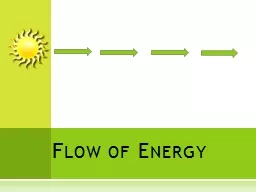

Source of Energy Raise your hand if you included this on your schoolyard diagram The Sun provides the light and heat energy for most forms of life on Earth Sun Sol Producers Producers chemically change solar light energy in the chlorophyll the green color in the plant into ID: 515400
Download Presentation The PPT/PDF document "Flow of Energy" is the property of its rightful owner. Permission is granted to download and print the materials on this web site for personal, non-commercial use only, and to display it on your personal computer provided you do not modify the materials and that you retain all copyright notices contained in the materials. By downloading content from our website, you accept the terms of this agreement.
Slide1
Flow of EnergySlide2
Source of Energy
Raise your hand if you included this on your schoolyard diagram.
The Sun provides the light and heat energy for most forms of life on Earth.
Sun = SolSlide3
Producers
Producers chemically change solar (light ) energy in the chlorophyll (the green color in the plant) into
their food.
Plants are producers
.Slide4
Food
Plants make this food for their own use. They need the energy to survive and thrive.Plants store the food in many places: roots, stems, leaves, and fruits.
Plants make food during the process called photosynthesis.Slide5
Photosynthesis
To undergo photosynthesis, plants need:SunlightWater
Carbon dioxide
Carbon DioxideSlide6
Plants Use their food
Plants use food to grow.Plants use stored energy (food) when the resources they need to grow and thrive are unavailable.
Plants use food to survive harsh environmental conditions, such as drought or cold winters.Slide7
Consumers
Consumers are organisms that get their energy by eating either producers (plants) or other consumers (animals).They use this energy to survive, grow, and reproduce .Slide8
Flow of energy
Let’s look at some of the diagrams you completed in your science notebook on the first day of this lesson.
What do they have in common?Slide9
Food Chains
When energy is transferred through organisms it is called a food chain. Arrows are used to show the
direction the energy is flowing.In the schoolyard, you might see:
Remember, nearly every food chain starts with energy from the Sun.Slide10
Example
Use the strips of paper to create a food chain for organisms that live in one of the Earth’s ecosystems. It might be the Arctic or the ocean, forest or desert, or grassland
or jungle.Cut six strips of paper of different sizes, as shown here.Color the widest strip yellow. This will represent the Sun.Slide11
Example
Write the name of a plant on the second widest strip of paper. On the third widest paper, write the name of an organism that eats the plant.
On the fourth widest strip, write the name of an animal that eats the organism on the second strip. On the fifth and sixth strips, continue the sequence. If you are unable to think of any organisms, name another plant, or a second animal, that may eat one of the organisms listed.
Carnivore
Carnivore
Plant
Carnivore
HerbivoreSlide12
Food Chain
Link your food chain together beginning with the Sun. Add the producer and then the consumers (herbivores and carnivores). Use tape to secure the link.
Sun
Producer
Consumer:
Herbivore
Consumer:
Carnivore
Consumer:
CarnivoreSlide13
Comparing food chains
Work in groups of four to compare the food chains that were created.What do the food chains have in common with each other?
Could any food chains overlap with each other?
Flounder
Porpoise
Plankton
Small Mullet
ShrimpSlide14
Food Webs
When food chains overlap, a food web is formed.Use the chains in your group to form a food web.Draw the food web in your science notebook.
Flounder
Porpoise
Plankton
Small Mullet
Shrimp
Trout
Sea Gull
CrabSlide15
Decomposers
Decomposers are organisms such as fungi, bacteria, and animals that play a major role in breaking down dead matter and returning nutrients to the soil. They also play a role in the nitrogen cycle.Slide16
decomposers
Add some decomposers to your food web.
Flounder
Porpoise
Plankton
Small Mullet
Shrimp
Trout
Sea Gull
Crab
Bacteria
MoldSlide17
The most important role
The most important role an organism (producer, consumer, or decomposer) plays in the ecosystem is ______ because ______.Slide18
Compare Roles in the Ecosystem